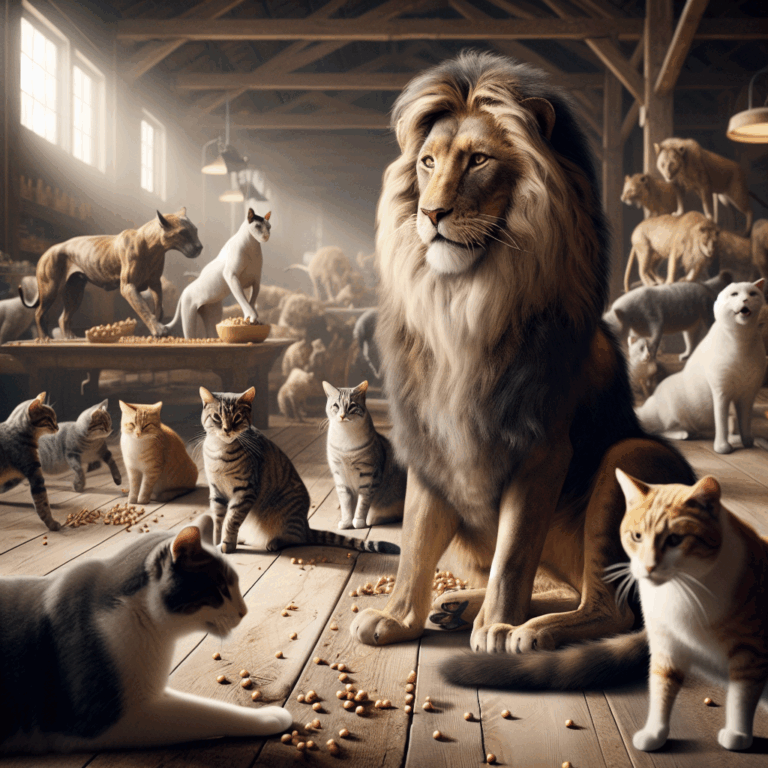The Feline Innovators of Behavioral Science: Cats and Their Role in Understanding Animal Behavior
- 17 Comments
In the ever-evolving field of behavioral science, cats have emerged as unexpected yet significant contributors. For years, researchers have been fascinated by feline behavior, not just for their enigmatic nature but also for the insights they provide into animal cognition, social interaction, and communication. Recent studies have begun to unveil the profound influence cats have on understanding broader animal behavior and even human psychology.
One of the key areas where cats have made substantial contributions is in the study of animal social structures. Unlike dogs, which have a more hierarchical pack-based social system, cats exhibit a more fluid and complex social dynamic. This has led scientists to explore how individual personalities and environmental factors influence social interactions among animals. By observing domestic and feral cats, researchers have been able to draw parallels between feline social strategies and those of other species, providing a broader understanding of social adaptability and cooperation.
Cats are also at the forefront of understanding the nuances of animal communication. Their wide range of vocalizations, body language, and pheromonal signals offers a rich tapestry for scientists to decode. This has not only enriched our understanding of interspecies communication but has also led to advancements in artificial intelligence, where feline behavior models are used to enhance the development of responsive AI systems that mimic complex communication patterns.
Furthermore, behavioral studies on cats have shed light on the concept of animal empathy and emotional intelligence. Cats have been observed to exhibit behaviors that suggest a form of empathy towards humans and other animals, challenging long-held beliefs that empathy is a uniquely human trait. These observations have spurred further research into the emotional lives of animals, and how such traits may have evolved across different species.
The implications of these studies extend beyond the realm of academic curiosity. Understanding cat behavior has practical applications in enhancing animal welfare standards, developing better enrichment programs for shelter animals, and even improving human-animal relationships. Insights gained from feline behavior have also been instrumental in designing interventions for animals with behavioral issues, ultimately leading to more successful adoptions and reduced euthanasia rates in shelters.
Moreover, the study of cat behavior has influenced the fields of neurobiology and psychology. By examining how cats process information and respond to stimuli, researchers are gaining valuable insights into the workings of the mammalian brain, potentially unlocking new approaches to treating neurological disorders in both animals and humans.
In conclusion, the role of cats in the study of behavioral science is both pivotal and transformative. As researchers continue to delve into the complexities of feline behavior, the knowledge gained not only enhances our understanding of our feline companions but also contributes to a broader comprehension of animal and human behavior. Cats, with their mysterious and multifaceted nature, are proving to be invaluable partners in the quest to unravel the secrets of the animal kingdom and beyond. As the field progresses, the humble house cat may well hold the key to some of the most profound discoveries in behavioral science.

In the ever-evolving field of behavioral science, cats have emerged as unexpected yet significant contributors. For years, researchers have been fascinated by feline behavior, not just for their enigmatic nature but also for the insights they provide into animal cognition, social interaction, and communication. Recent studies have begun to unveil the profound influence cats have on understanding broader animal behavior and even human psychology.
One of the key areas where cats have made substantial contributions is in the study of animal social structures. Unlike dogs, which have a more hierarchical pack-based social system, cats exhibit a more fluid and complex social dynamic. This has led scientists to explore how individual personalities and environmental factors influence social interactions among animals. By observing domestic and feral cats, researchers have been able to draw parallels between feline social strategies and those of other species, providing a broader understanding of social adaptability and cooperation.
Cats are also at the forefront of understanding the nuances of animal communication. Their wide range of vocalizations, body language, and pheromonal signals offers a rich tapestry for scientists to decode. This has not only enriched our understanding of interspecies communication but has also led to advancements in artificial intelligence, where feline behavior models are used to enhance the development of responsive AI systems that mimic complex communication patterns.
Furthermore, behavioral studies on cats have shed light on the concept of animal empathy and emotional intelligence. Cats have been observed to exhibit behaviors that suggest a form of empathy towards humans and other animals, challenging long-held beliefs that empathy is a uniquely human trait. These observations have spurred further research into the emotional lives of animals, and how such traits may have evolved across different species.
The implications of these studies extend beyond the realm of academic curiosity. Understanding cat behavior has practical applications in enhancing animal welfare standards, developing better enrichment programs for shelter animals, and even improving human-animal relationships. Insights gained from feline behavior have also been instrumental in designing interventions for animals with behavioral issues, ultimately leading to more successful adoptions and reduced euthanasia rates in shelters.
Moreover, the study of cat behavior has influenced the fields of neurobiology and psychology. By examining how cats process information and respond to stimuli, researchers are gaining valuable insights into the workings of the mammalian brain, potentially unlocking new approaches to treating neurological disorders in both animals and humans.
In conclusion, the role of cats in the study of behavioral science is both pivotal and transformative. As researchers continue to delve into the complexities of feline behavior, the knowledge gained not only enhances our understanding of our feline companions but also contributes to a broader comprehension of animal and human behavior. Cats, with their mysterious and multifaceted nature, are proving to be invaluable partners in the quest to unravel the secrets of the animal kingdom and beyond. As the field progresses, the humble house cat may well hold the key to some of the most profound discoveries in behavioral science.



17 thoughts on “The Feline Innovators of Behavioral Science: Cats and Their Role in Understanding Animal Behavior”
Pingback: cheap xifaxan usa buying
Pingback: purchase rifaximin generic australia
Pingback: buying avodart low price
Pingback: buy staxyn buy from canada
Pingback: purchase itraconazole generic from india
Pingback: order fildena generic pharmacy canada
Pingback: Order gabapentin online no membership overnight shipping
Pingback: buy dutasteride generic effectiveness
Pingback: cheap flexeril cyclobenzaprine buy adelaide
Pingback: order androxal canada fast shipping
Pingback: purchase enclomiphene cheap uk buy purchase
Pingback: acheter kamagra sans ordonnance ni adhésion
This post wonderfully highlights the unique contributions of cats to the field of behavioral science, showcasing their influence on understanding both animal and human behavior.
It’s great to see the appreciation for the unique role cats play in behavioral science. Their influence on understanding behavior across species is indeed fascinating.
This post highlights the fascinating contributions of cats to behavioral science, showcasing their significant impact on our understanding of animal and human behavior.
It’s intriguing how the article credits cats with the advancements in behavioral science, yet it seems to overlook the substantial contributions of other species in this field.
This post provides an insightful look into how cats contribute significantly to our understanding of animal behavior and psychology.